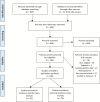A Systematic Review and Meta-analysis of Ventilator-associated Pneumonia in Adults in Asia: An Analysis of National Income Level on Incidence and Etiology
- PMID: 29982303
- PMCID: PMC6336913
- DOI: 10.1093/cid/ciy543
A Systematic Review and Meta-analysis of Ventilator-associated Pneumonia in Adults in Asia: An Analysis of National Income Level on Incidence and Etiology
Abstract
Background: Ventilator-associated pneumonia (VAP) is the commonest hospital-acquired infection (HAI) in intensive care. In Asia, VAP is increasingly caused by resistant gram-negative organisms. Despite the global antimicrobial resistance crisis, the epidemiology of VAP is poorly documented in Asia.
Methods: We systematically reviewed literature published on Ovid Medline, Embase Classic, and Embase from 1 January 1990 to 17 August 2017 to estimate incidence, prevalence, and etiology of VAP. We performed a meta-analysis to give pooled rates and rates by country income level.
Results: Pooled incidence density of VAP was high in lower- and upper-middle-income countries and lower in high-income countries (18.5, 15.2, and 9.0 per 1000 ventilator-days, respectively). Acinetobacter baumannii (n = 3687 [26%]) and Pseudomonas aeruginosa (n = 3176 [22%]) were leading causes of VAP; Staphylococcus aureus caused 14% (n = 1999). Carbapenem resistance was common (57.1%).
Conclusions: VAP remains a common cause of HAI, especially in low- and middle-income countries, and antibiotic resistance is high.
Figures




References
-
- Rosenthal VD, Maki DG, Mehta A, et al. ; International Nosocomial Infection Control Consortium Members International Nosocomial Infection Control Consortium report, data summary for 2002-2007, issued January 2008. Am J Infect Control 2008; 36:627–37. - PubMed
-
- Rosenthal VD, Al-Abdely HM, El-Kholy AA, et al. . International Nosocomial Infection Control Consortium report, data summary of 50 countries for 2010-2015: device-associated module. Am J Infect Control 2016; 44:1495–504. - PubMed
-
- Kollef MH, Hamilton CW, Ernst FR. Economic impact of ventilator-associated pneumonia in a large matched cohort. Infect Control Hosp Epidemiol 2012; 33:250–6. - PubMed
-
- Alp E, Kalin G, Coskun R, Sungur M, Guven M, Doganay M. Economic burden of ventilator-associated pneumonia in a developing country. J Hosp Infect 2012; 81:128–30. - PubMed
-
- Melsen WG, Rovers MM, Groenwold RH, et al. . Attributable mortality of ventilator-associated pneumonia: a meta-analysis of individual patient data from randomised prevention studies. Lancet Infect Dis 2013; 13:665–71. - PubMed
Publication types
MeSH terms
Grants and funding
LinkOut - more resources
Full Text Sources
Other Literature Sources
Medical

